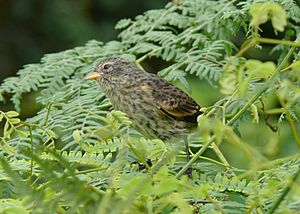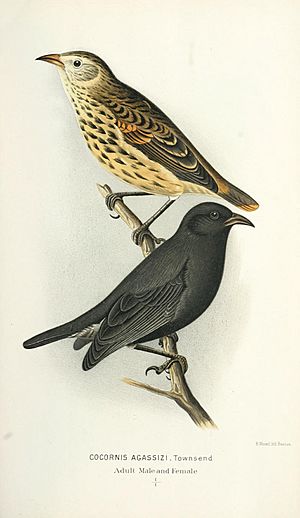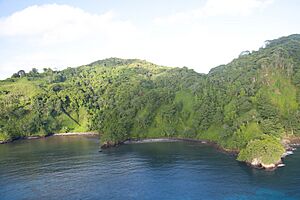Cocos finch facts for kids
Quick facts for kids Cocos finch |
|
|---|---|
 |
|
| Cocos Finch, female | |
 |
|
| Cocos Finch, male | |
| Conservation status | |
| Scientific classification | |
| Genus: |
Pinaroloxias
|
| Species: |
inornata
|
The Cocos finch or Cocos Island finch (Pinaroloxias inornata) is a special bird. It's the only one of the famous Darwin's finches that doesn't live in the Galápagos Islands. In fact, it's the only bird in its entire group, called Pinaroloxias.
Scientists used to think it belonged to the sparrow family. But newer studies show it's actually part of the tanager family, called Thraupidae. This unique bird lives only on Cocos Island. This island is in the Pacific Ocean, about 360 miles (580 km) south of Costa Rica.
Contents
About the Cocos Finch
The Cocos finch was first officially described in 1843 by an English bird expert named John Gould. Later, in 1885, another expert, Richard Bowdler Sharpe, placed it in its own special group, Pinaroloxias. The name Pinaroloxias comes from old Greek words meaning "dirty" and a bird group called Loxia. The second part of its scientific name, inornata, is Latin for "plain" or "unadorned".
Even though it lives far from the Galápagos, the Cocos finch looks a lot like other Darwin's finches. What's really interesting is how they eat. Different Cocos finches can have different ways of finding food. Scientists think they learn these special eating habits from each other. These differences in how they eat don't depend on how they look, or if they are male or female, or how old they are. Even with these different eating styles, they are all considered the same species.
What Does a Cocos Finch Look Like?
The Cocos finch is about 12 cm (4.7 inches) long and weighs around 12.5 grams (0.44 ounces). It has a black, curved, pointed beak. This beak is perfect for eating berries and insects, which are its main foods.
Male and female Cocos finches look different. This is called Sexual dimorphism.
- Males are almost completely black. Their feathers are black from their tail to their chest, neck, and head. Unlike male finches on the Galápagos Islands, male Cocos finches have black beaks all year round.
- Females have lighter brown feathers. They have black spots on their chest down to their sides. Their belly is a milky white color. The neck and head area of females are more noticeably black.
- Young finches look similar to females but have yellow beaks.
The call of a Cocos finch sounds "buzzy" and ends with a high-pitched note. It might start with a "djirr" sound, followed by a high "tiew." They can also make a high-pitched "phzzzz" sound.
Where Do Cocos Finches Live?
The Cocos finch lives only on Cocos Island. This island is about 580 km (360 miles) southeast of Costa Rica. The island itself is quite large, but the Cocos finches only live in a smaller area of about 30 km2 (11.5 square miles). They don't travel outside of Cocos Island.
Their home is mostly in thick bushes, dense forests, and woodlands. Cocos Island has a typical rainforest climate. This means it's very humid and often rains. The island has different landscapes, including lakes, streams, and caves. It's also home to other unique animals, like two types of lizards found nowhere else.
How Do Cocos Finches Behave?
Finding Food
Cocos finches are known as "generalist species." This means they can eat many different kinds of food. However, individual finches can become very good at finding specific types of food. This leads to different ways of foraging (finding food) among them. As mentioned earlier, they can learn these special eating habits from other Cocos finches.
Breeding and Nests
Cocos finches usually build nests throughout the year. But their main breeding season is usually in January and February. They build their nests using materials like lichen and dry moss. Their nests are roughly round and are built at the end of a tree branch.
A female usually lays two white eggs with brown spots. The eggs are about 4 to 5 in a clutch and have distinctive pink or light brown spots.
Dangers They Face
Cocos finches face threats from animals like rats and cats that were brought to the island by humans. However, scientists haven't found much evidence that these predators are causing a big problem for the finches. Because there aren't many predators, scientists think the finches have developed their special eating habits to become more adaptable.
How Are They Doing?
Cocos Island is a protected natural reserve. This means there isn't much human interaction with the Cocos finches or other wildlife there. While more tourists are visiting the island, there's no sign that they are bothering the wildlife, including the Cocos finch.
Even though they live in a small area, the Cocos finch population is stable. They don't face many predators or disturbances. Because of this, the IUCN says the Cocos finch is a species of "Least Concern." This means they are not currently in danger of disappearing.
Right now, it's estimated that there are about 6,000 to 15,000 Cocos finches living on Cocos Island.
See also
 In Spanish: Pinzón de Darwin de la Cocos para niños
In Spanish: Pinzón de Darwin de la Cocos para niños




